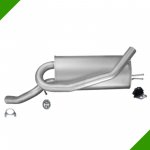The exhaust pulses.
As each exhaust valve opens, the gases rush out, (at about 180mph, if my memory serves). The valve shuts, the gases are still moving, creating a vacuum behind them. This then causes the gases to return a little, a bit like two steps forward, and one back.
The pulse needs to exit the tailpipe cleanly. The manufacturer has taken a lot of effort to get this best for overall performance.
With a larger pipe, the pulses will travel a shorter distance each time. So the end may need to be slightly longer, or shorter. Similarly with a narrower pipe. The silencer, even with a straight-through pipe inside, will have that pipe perforated. That breaks up the gas flow, removing some noise, but replacing with a straight pipe, may change the pulse position at the end of the pipe. You may get more noise, coupled with less power.
This is why so many cars with large tailpipes make a lot of noise, but seem to struggle to pull themselves along.
So good luck with the experimenting. Be prepared to refit a new backbox, so ensure your cuts will allow that.

